One of the core reasons I make books now is because Ray Bradbury scared me so happy, that I am perpetually compelled to do is at best, ignite the same flame in a young reader today. Most of my comics, certainly the ones I write myself, are scary ones or revolve around scary themes. In the last ten years I began to notice that they also featured as protagonists, children. Even when the overall story wasn’t necessarily about them, there they were peeking from behind some safe remove, watching. I came to understand the pattern was leading me to a more clearly define ethos when I both had kids of my own and I came to find that the comics industry had for the most part decided not to make books for kids anymore, Instead they wanted to tailor even their brightly colored, undies-on-the-outside superhero books to old men nostalgic for their long passed childhoods than for the children they were intended to inspire. Insane, right? This generation had not only stolen the medium away from its following generations, it had helped foster one of the greatest publishing face-plants in American history: it killed its own future by ignoring the basic need to grow a new crop of readers, and so made certain it had no future at all. And one thing no one was going near was horror stories for kids. Clinton was president and we hadn’t yet learned about the wonderful effect anthrax-laced letters, the Washington DC snipers, and everyone losing their jobs would have on us. (To be perfectly honest, I think i like many others existed in a continual state of fear from mid 2001- all the way up to last wednesday). The time has become ripe again and with the collapse of the DC and Marvel models, it was time to do what they wouldn’t: scare the hell out of kids and teach them to love it. Here’s why this is not as crazy as it sounds:
Reason #1.) CHILDHOOD IS SCARY
Maurice Sendak, whom I love as a contributor to the lore of children’s literature as well as a dangerous and wily critic of the medium, (especially his grouchy latter years), once countered a happy interviewer by demanding she understand that childhood was not a skip-hop through a candy-cane field of butterflies and sharing and sunshine, that is was in fact a terrifying ordeal he felt compelled to help kids survive. Kids live in a world of insane giants already. Nothing is the right size. The doorknobs are too high, the chairs too big… They have little agency of their own, and are barely given the power to even choose their own clothes, (though no real “power” can ever be given anyway… maybe “privilege” is the right term). Aside from the legitimate fears of every generation, kids today are enjoying seeing these madhouse giants lose their jobs, blow themselves up using the same planes they ride to visit grandma and catastrophically ruin their own ecosystem ushering in a new era of unknown tectonic change and loss their grandkids will get to enjoy in full. The insane giants did to the world what they did to comics: they didn’t grow a future, but instead ate it for dinner.
It’s a spooky time to be a kid, even without Sandy Hook making even the once fortified classroom a potential doomsday ride. Look, the kids are already scared, so let’s give them some tools to cope with it beyond telling them not to worry about it all… when they really have every right to be scared poopless. Scary stories tells kids there’s always something worse, and in effect come across as more honest because they exercise in a realm already familiar to them. Scary tales don’t warp kids, they give them a place to blow off steam while they are being warped by everything else.
Reason #2.) POWER TO THE POWERLESS
The basic thing horror does for all of us is also its most ancient talent, the favorite system of crowd control invented by the ancient Greeks: catharsis. Who doesn’t walk out of a movie that just scared the pants off of them mercifully comforted by the mundane walk to through the parking lot and the world outside? For kids this is even more acute. If we take it further and make children both the object of terror in these stories as well as agents for surviving the monsters… well now you’re onto something magical. Plainly put, horror provides a playground in which kids can dance with their fears in a safe way that can teach them how to survive monsters and be powerful too. Horror for kids lets them not only read or see these terrible beasts, but see themselves in the stories’ protagonists. The hero’s victory is their victory. The best is whomever they find beastly from their lives. A kid finishing a scary book, or movie can walk away having met the monster and survived, ready and better armed for the next villain that will be coming.
Reason #3.) HORROR IS ANCIENT AND REAL AND CAN TEACH US MUCH
In the old days, fairy tales and stories for kids were designed to teach them to avoid places of danger, strangers and weird old ladies living in candy covered houses. They were cautionary tales for generations of kids who face death real and tangible almost each and every day. There was a real and preventive purpose to them: stay alive and watch out for the myriad of real world threats that haunt your every step. These stories of course were terrifying, but these are also children that grew up in a time where of every six kids born two or three would survive to adulthood. Go and read some of the original Oz books by Baum and tell me they are not freakishly weird and threatening. The Brothers Grimm sought to warn kids in the most horrifying way they could. So much so, that these types of tales have all but vanished from children’s lit comparatively, because these days they are deemed to frightening and dark for them. But they also are now more anecdotal than they were then, the mean less because the world around them grew and changed and they remained as they had always been. They became less relevant, however fantastic and crazy-pants they were.
Horror also touches something deep within us right down into our fight or flight responses. We have grown from an evolutionary necessity to be afraid of threats so we might flee them and survive to make more babies that can grow up to be suitably afraid of threats, that can also grow up and repeat the cycle. We exist today because of these smart apes and they deserve our thanks for learning that lesson. As a result, like almost all pop culture, horror lit can reflect in a unique way, the extremely scary difficulties of being a child in a certain time. It touches on something we all feel and are familiar with and as such can reveal deep understanding of ourselves as we go through the arc of being scared, then relieved, and then scared again. The thrill is an ancient one, and when we feel it, we’re connecting with something old and powerful within us. Whether its a roller-coaster, a steep water-slide, or watching Harry Potter choke down a golden snitch as he falls thirty stories from his witch’s broom. There is a universality in vicarious thrill seeking and danger hunting. It is us touching they who began the cycle forty thousand years past.
Reason #4.) HORROR CONFIRMS SECRET TRUTHS
“You know when grown ups tell you everything’s going to be fine and there’s nothing to be worried about, but you know they’re lying?” says Doctor Who of a young mortified Amy Pond. “uh-huh” she replies rolling her ten year old eyes dramatically. The Doctor leans in, a wink in his eye and intimates… “Everything’s going to be fine”. And then they turn to face the monster living in her wall with a screwdriver in one hand and a half eaten apple in the other.
In doing this Moffat touches brilliantly upon another essential truth of horror- that it shows us guardians and guides that will be more honest with us than even our own parents. Within the darkness and shadows is our guide that can lead us out and back into the light, but you can only find him there in the darkness, when you need him most. Kids are aware of so much more that’s happening in their house than we as parents even want to imagine. But because we don’t share all the details of our anxious whispers, stressful phone calls, or hushed arguments, ( and rightfully so), they are left to fill in the facts themselves, and what one imagines tends to be far more terrible than what is real. They know you’re fighting about something, but not what. They can tell what hastened whispers in the hall means outside their door… or they think they do. And what they don’t know for a fact, they fill in with fictions. Storytellers dabbling in horror provide them with an honest broker who doesn’t shy away from the fact of werewolves or face-eating aliens that want to put their insect babies in our stomachs. They look you straight into their eyes and whisper delightfully “Everything’s going to be fine”. The mere fact of telling these tales proves a willingness to join in with kids in their nightmares, bring them to life, and then subvert and vanquish them. They love you for this, because you are sharing a secret with them they don’t yet realize everyone else also knows: this is fun. The end result for me at least was a great sense of trust in scary movies I never got from my parents who tried to comfort me by telling me ghosts weren’t real. Horror told me they were, but it taught me how to face them. We deny to our kids the full measure of what we experience and suffer as adults, but they aren’t idiots and know something’s going on, and what we’re really doing by accident is robbing them of the trust that they can survive, and that we understand this and can help the to do so. Where we as adults cannot tell them a half-truth, horror can tell them the whole, and there is a great mercy in that.
Reason #5.) SHARING SCARY STORIES BRINGS PEOPLE TOGETHER
How many times I have seen a group of kids discover to their excessive delight that they have all read and loved the same Goosebumps book? A LOT. The first thing they do is compare and ranks the scariest parts and laugh at how they jumped out of their bed when the cat came for a pat on the head, or stayed up all night staring at the half open closet. Like vets having shared a battle they are brought together in something far more essential and primordial than a mere soccer game or a surprise math test. And looking back myself, I cannot recall having more fun in a movie theater or at home with illicit late night cable tv, than when I was watching a scary movie with my friends. The shared experience, the screams and adrenaline induced laughter that always follows are some of the best and least fraught times in childhood. And going through it together means we aren’t alone anymore. Not really.
Reason #6.) HIDDEN INSIDE HORROR ARE THE FACTS OF LIFE
Growing up is scary and painful, and violent and your body is doing weird things and you might, to your great horror, become something beastly and terrible on the other side. (The Wolfman taught us this). Being weird can be lonely and your parents never understand you and the world is sometimes incomprehensible. (Just as Frankenstein’s monster showed us). Sex and desire is creepy and intimate in dangerous and potentially threatening ways (so sayeth Dracula). Whether it’s The Hunger Games as a clear cut metaphor for the darwinian hellscape of highschool, or learning to turn and face a scary part of ourselves, or the dangers of the past via any of the zillions of ghost stories around, horror can serve as a thinly veiled reflection of ourselves in a way almost impossible to imagine in other forms. Horror can do this because, like sci-fi and fantasy, it has inherent within it a cloak of genre tropes that beg to be stripped off. Its treasures are never buried so deep that you can’t find them with some mild digging. It’s a gift to us made better by having to root around for it, and like all deep knowledge, we must earn its boons rather than receive them, guppy-mouthed like babies on a bottle.
Fear is not the best thing in the world of course, but it’s not going anywhere and we are likely forced to meet it in some capacity great or small, each and every day. There’s no way around it. Denying this fact only provides more fertile ground for fear to take root. Worse yet, denying it robs us of our agency to meet and overcome it. The more we ignore scary things, the bigger and scarier those things become. One of the great truths from Herbert’s perpetually important Dune series is the Bene Gesserit’s Litany Against Fear:
Fear is the mind-killer.
Fear is the little death that brings total obliteration.
I will face my fear.
I will permit it to pass over me and through me.
And when it is gone past I will turn to see its path.
Where the fear has gone, there will be nothing.
Only I will remain.
In so many geeky ways this sums up the most important and primary element of fear- not to pretend it doesn’t exist, or whether it should or not, but to meet it, to hug it, and to let it go so we may be better prepared for whatever else comes next. Crafting horror narratives for kids does require changing the way scary things are approached, but I would argue that what tools we are required to take off the table for a younger audience aren’t really important tools in telling those stories in the first place. Rape, gore and splatter themes are terrible, deeply lazy and often poorly executed shortcuts for delivering weight and fear in a story. Losing them and being forced to employ more elegant and successful tools, like mood, pacing and off camera violence- the sorts of things one must do to make scary stories for kids- make these tales more interesting and qualitative anyway. We are forced to think more creatively when we are denied the alluring tropes of the genre to lean on. We are more apt to reinvent the genre is when we aren’t burdened by the rules all genres lure us into adopting. With kids one must land on safer ground sooner than would be the case with adults, but otherwise what I do as a writer when I tell a scary story to kids is essentially the same thing I would do to craft one for adults. There are certain themes that require life experience to understand as a reader as well and a successful storyteller should know their audience. So don’t be afraid to scare your kids, or your kids’ friends with scary books you love. Obviously you have to tailor things to your kids’ individual levels. For example, films and books I let my 11 year-old digest, I won’t let my younger boy get into until he’s 14. They’re just different people and can handle different levels of material. They both love spooky stuff, but within their individual limits. Showing The Shining to an 8-year old is generally a poor idea, so my advice is when there’s doubt, leave it out. You can’t make anyone un-see what you show them, and you should be responsible as to what they are exposed to. I’m a bit nostalgic for sneaking into to see The Exorcist at the dollar cinema way too young, but I also remember what it felt like to to wake up with twisty-headed nightmares for a month after too. Being scared and being terrorized are not the same thing. Know the difference and don’t cross the streams or it will totally backfire on you. But if you navigate it right, it can be a completely additive and powerful experience.
So get out there and scare some kids today! Do it right and they’ll thank you when they’re older. There will be a lot of adults who find this whole post offensive and terrible, even as their kids cry for the material… to them I remind them that children are often smarter than the adults they wind up becoming. The parents that find this so inappropriate are under the illusion that if they don’t ever let their kids know any of this stuff, they won’t have bad dreams or be afraid, no knowing that tragically they are just making them more vulnerable to fear. Let the kids follow their interests, but be a good guardian rather than an oppressive guard. Only adults are under the delusion that childhood is a fairy rainbow fantasy land, just let your kids lead on what they love, and you’ll be fine.


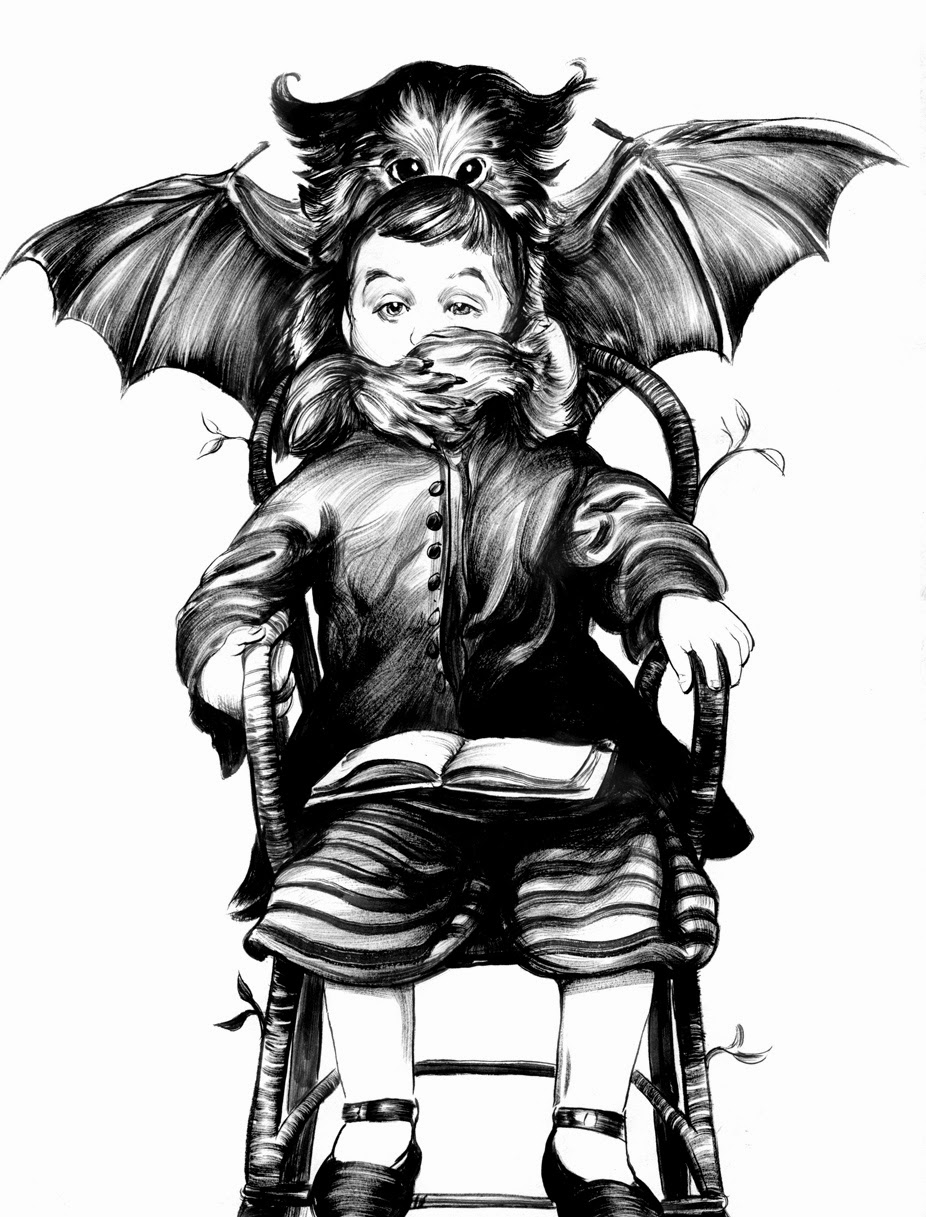
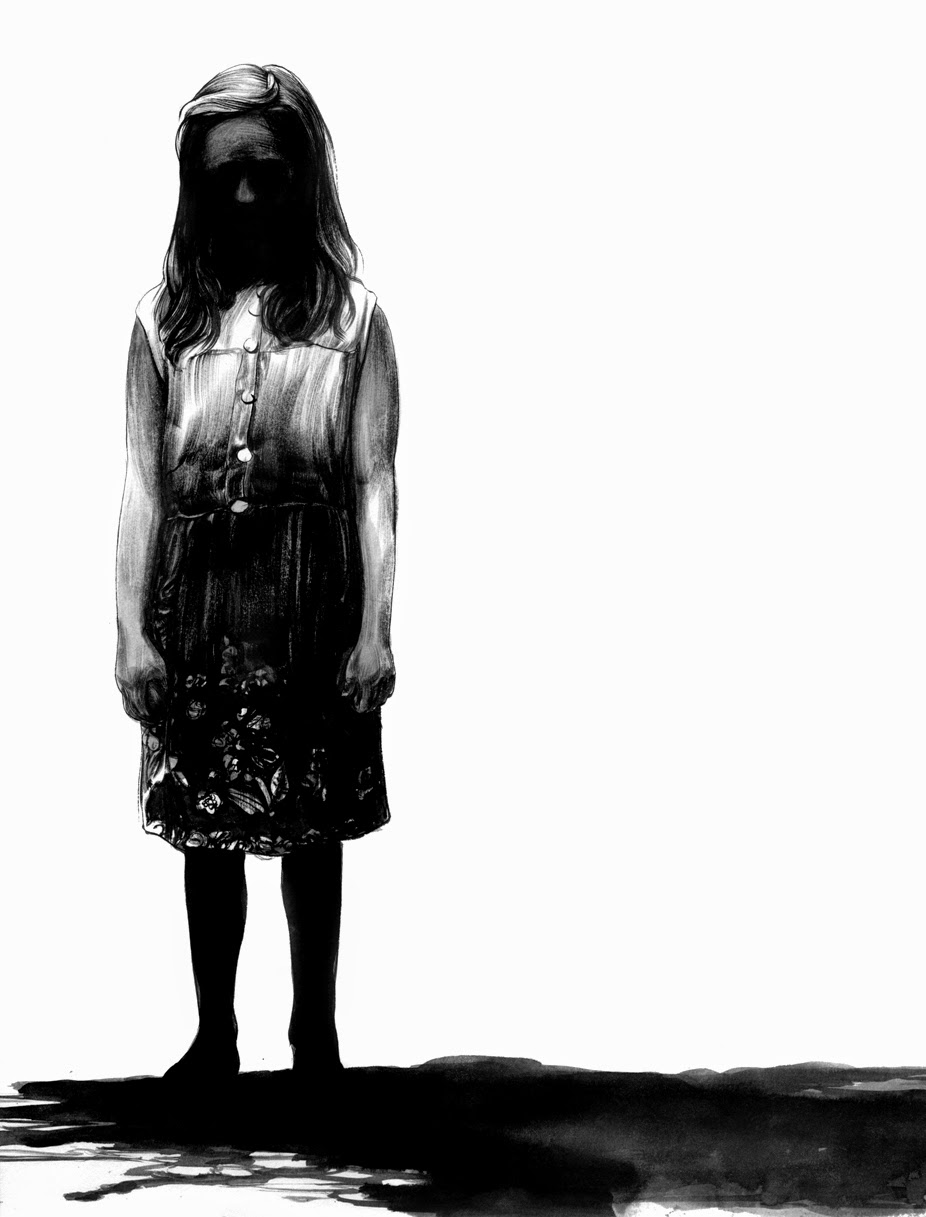
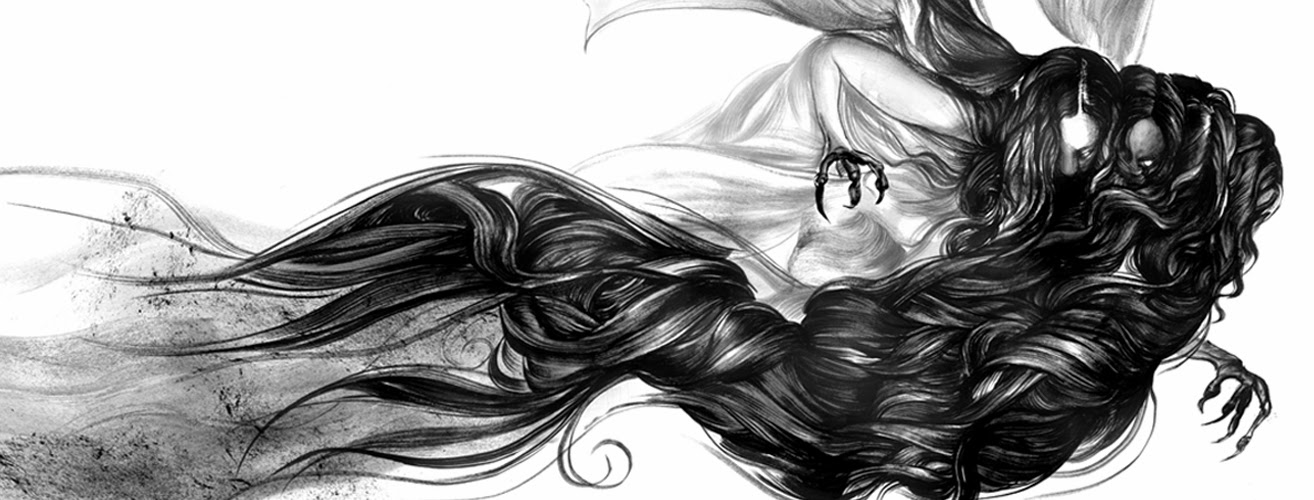
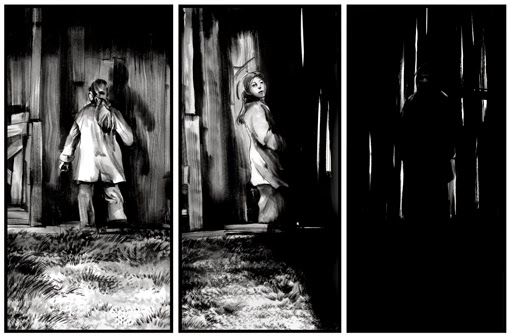
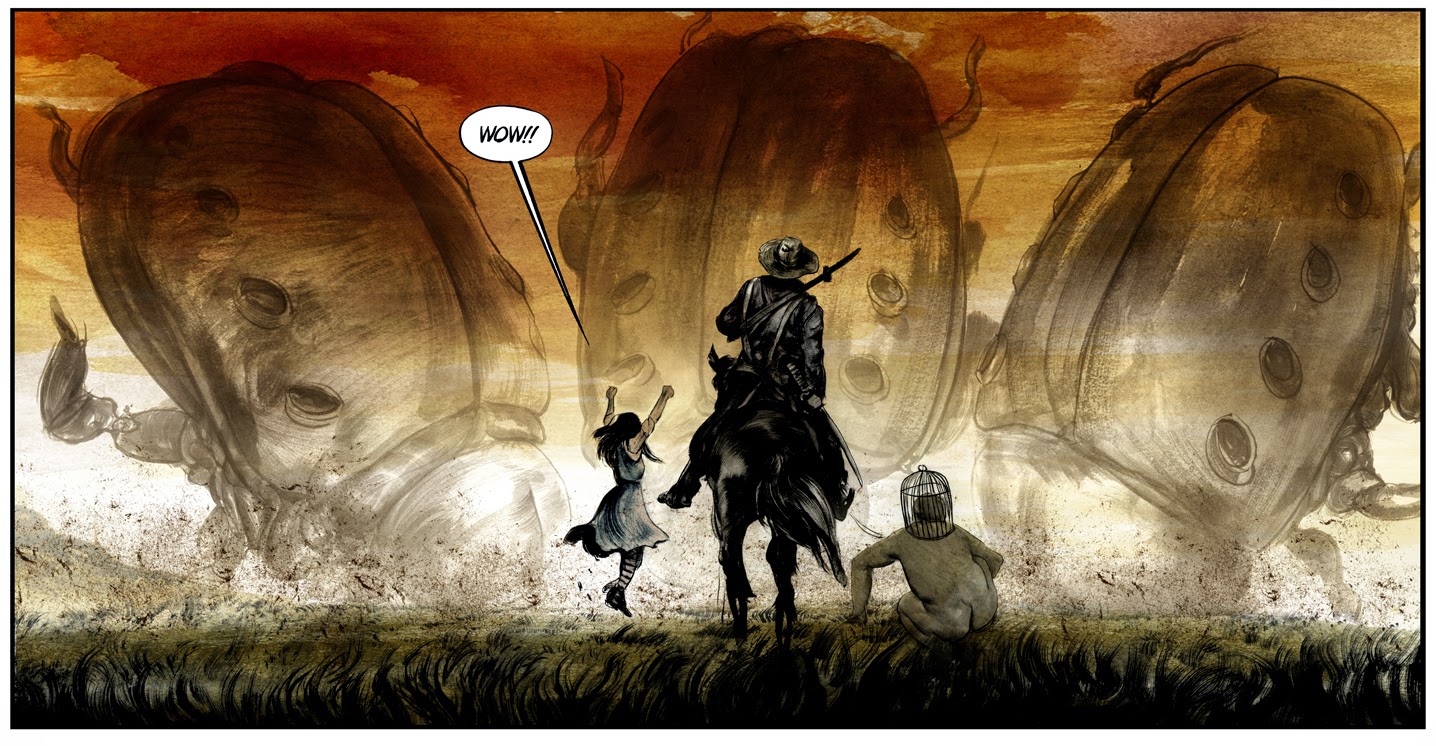

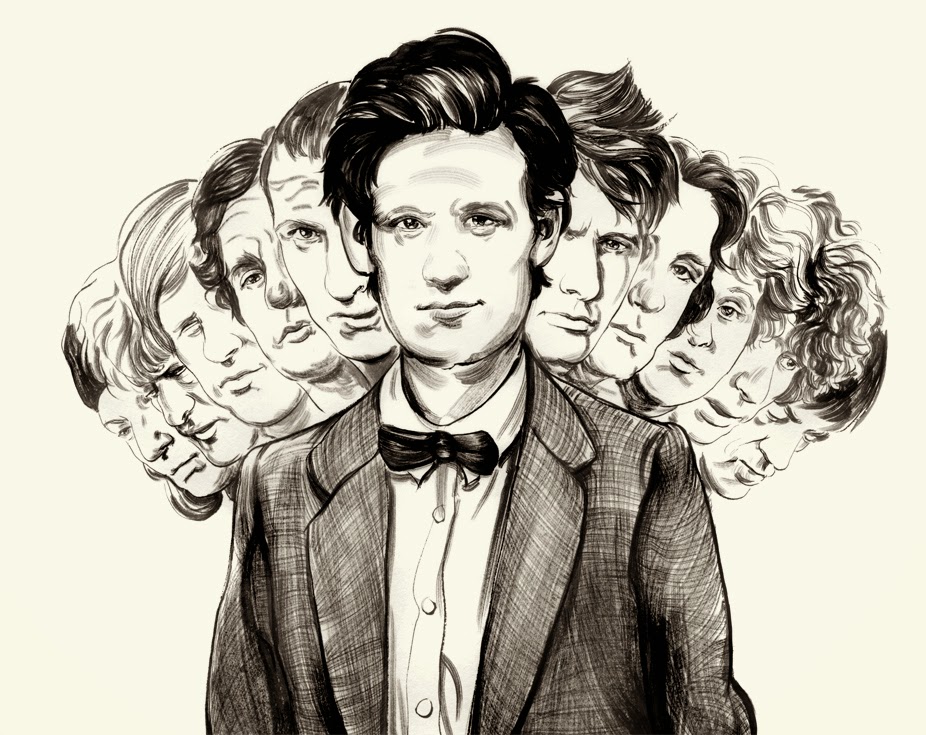
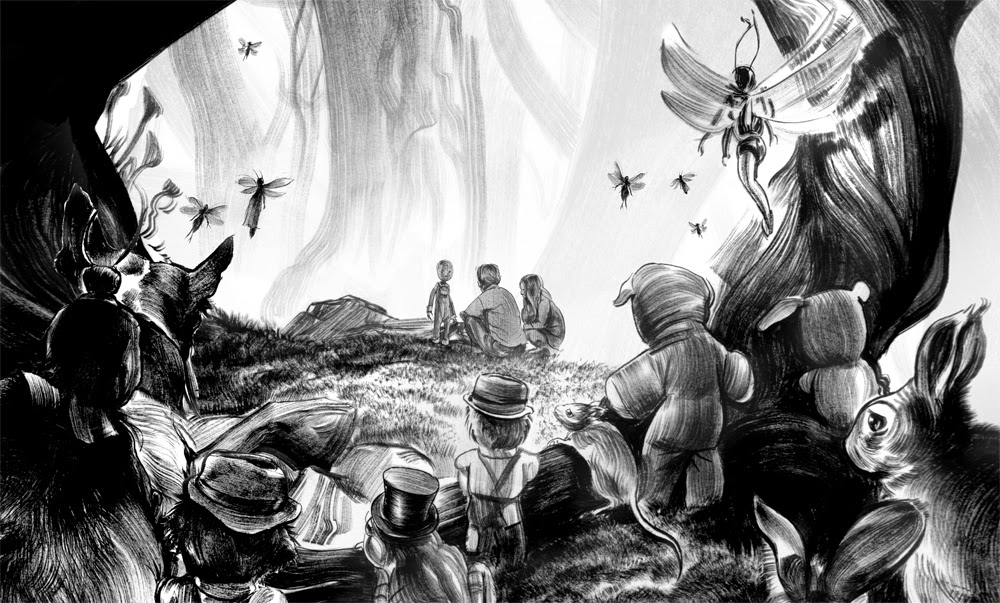

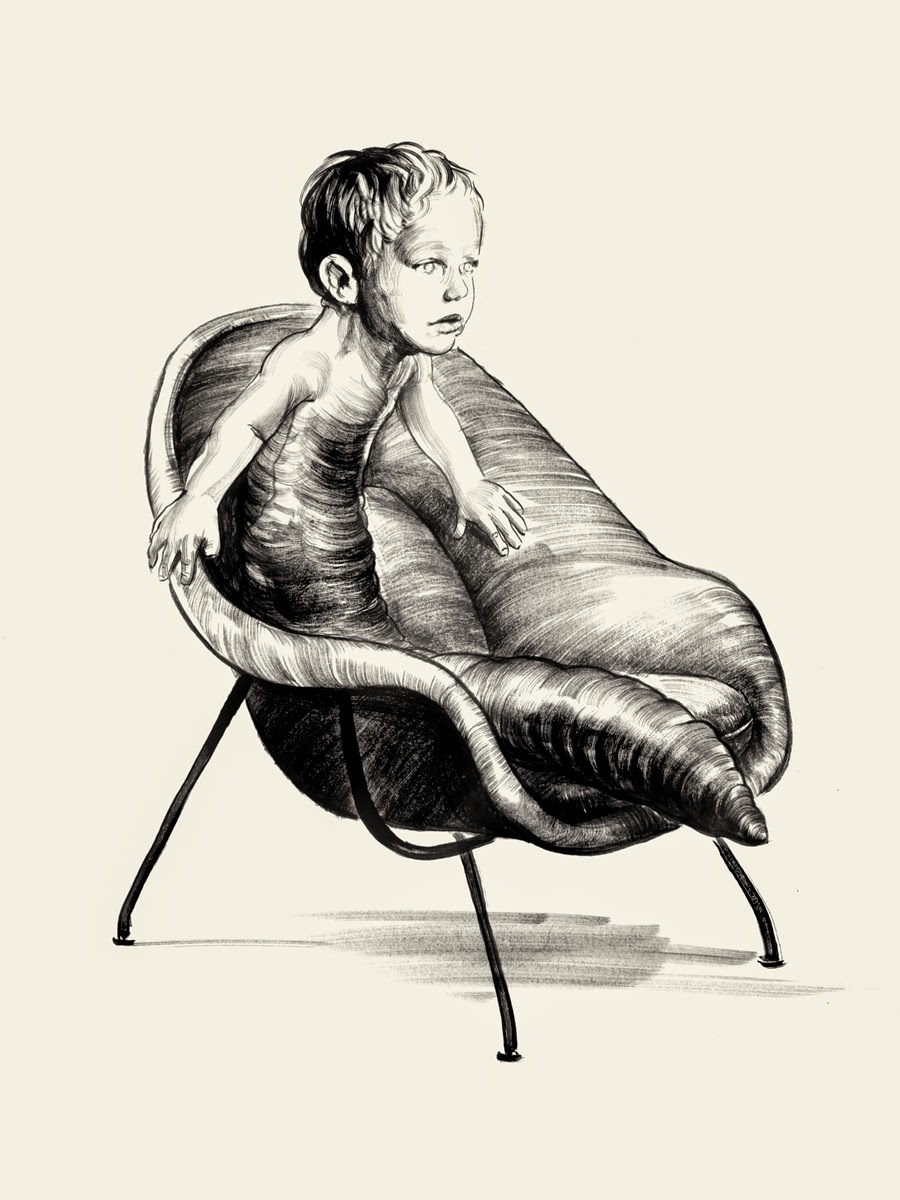
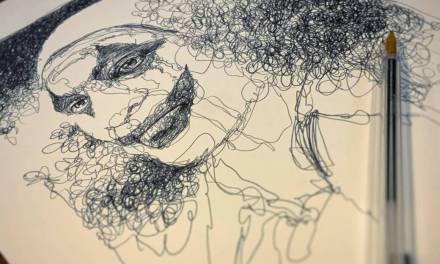
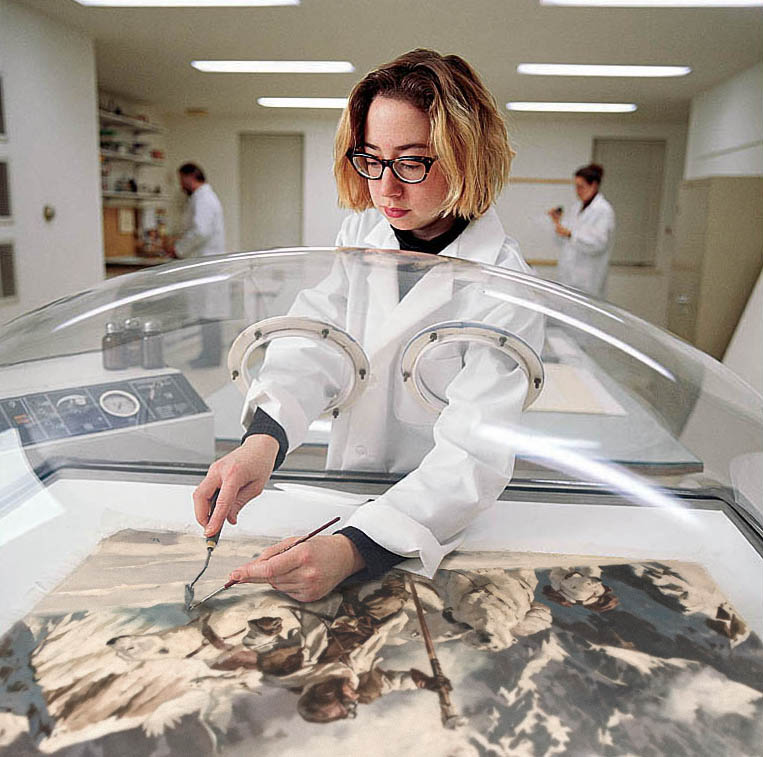
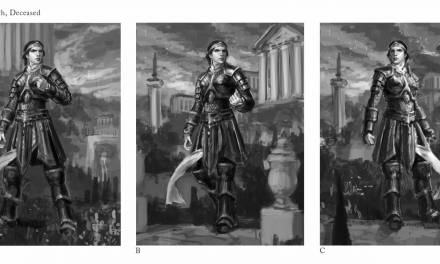
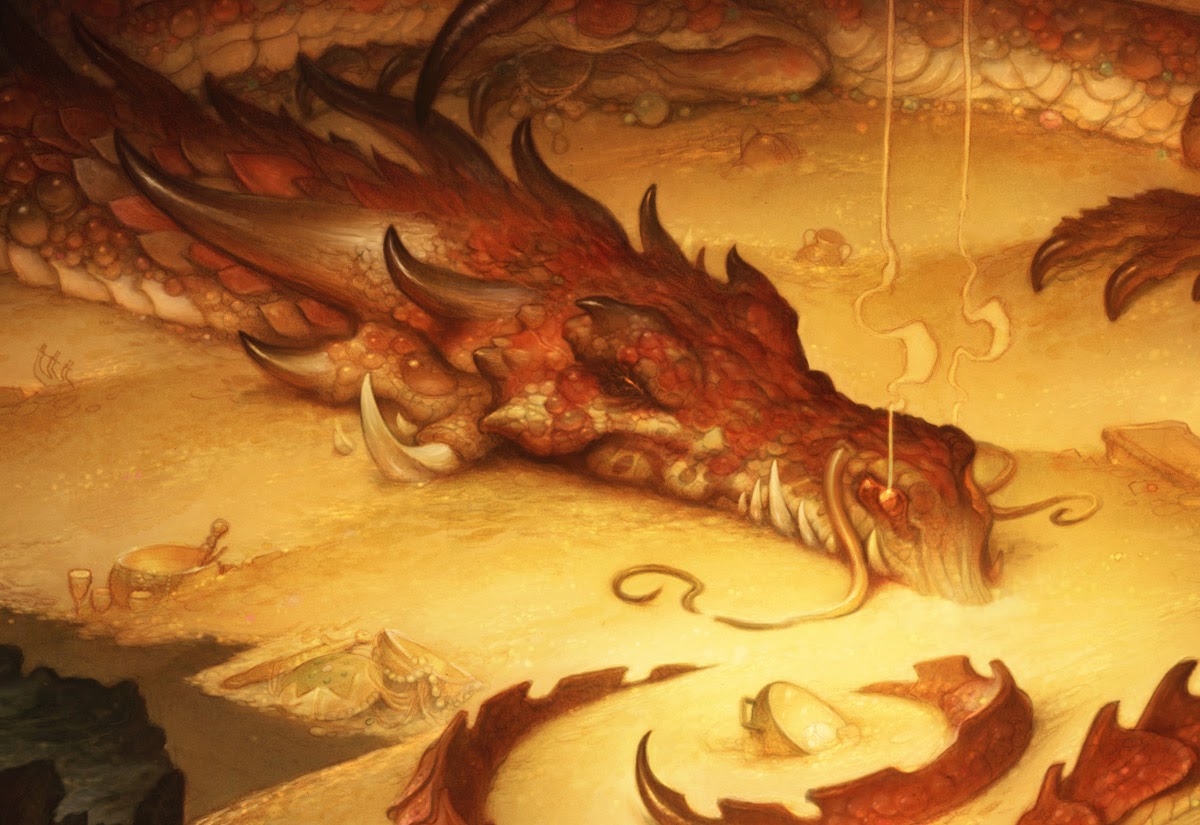

Great post, Greg. The reasons you list above are many of the same that I still use to explain my love of horror even now, as an adult.
There was a reason my favorite book during my first few years of elementary school was the new (then) Scary Stories to Tell in the Dark.
Love your ink work Greg! Geeky art question – what kind of paper do you use?
Thanks Chad- explain we must, a lot of people just to jive with the shadows like they should. I was a bit old for gossebumps when it first landed and i guess we didn't really have a cultural hotspot like that for horror… The adult horror of the seventies was incredible, and still reamins the high water mark for the filmic side of the genre, but i think the scariest i got put in front of was some errant Choose Your Own Adventure, or Alfred hitchcock and The Three Investigators. I always went to the spooky ones in that series.
Thanks Sal- i rely largely on the Starthmore “Alexis” 401 drawing paper in cream. Every few months i get NY Central to ship me up a couple of big reams of it, and i chew upon it until the casks are emoty. Great stuff, very affordable, excellent tooth. It's book weight, so a bit thin for some artists, but i don't care… I love it entirely.
Well-crafted and deeply thought-out posts like this are difficult–you made it look easy. I appreciate it and the time it took to create. Thanks!
The root of much we find terrifying and horrific is runaway imagination. An evocative idea, that germinates and spurs us inwardly to create outwardly what “could be”. Anticipation and escalation. Especially for children. I remember how much my little sisters loved being told stories of creeping dread and half-glimpsed things when we were kids.
Some of these are great examples of “less can be more”: http://justsomething.co/20-terrifying-two-sentence-horror-stories-that-will-make-you-hold-your-breath/
I believe one of the reasons lazy people go to the lengths of gore and rape is because our kids' imaginations have been suppressed. Everything is given them and there are few mysteries to explore. Why create an adventure when one is given to you on a device? This post is so well put and written Greg. To scare and to inspire imagination and mystery and not to terrorize. I think you have a future. Thanks for the thoughful writing.
The Shining scared the crap out of me as an adult, even. I became aware of you when I saw The Drybrush Master, and I told a lot of my friends to watch it. I immediately bought Freaks of the Heartland and the Lost Boy, and I want to thank you for putting so much heart into what you do–I've been very inspired to get further into brush and ink work as a balance to being a full time oil painter. So it was really great to see you in MC. I, too, appreciate the time/thought you take to post.
Now for the Geek question. would you please share the name of the man who makes your favorite brushes?
Thanks again, and best wishes.
Very informative. It definitely made me think back on how I avoided scary movies as a kid. My two year old is still too young to benefit from this but I will definitely keep it all in mind when she is a few years older. I really like that top image by the way.
FANTASTIC article! I have sometimes struggled to articulate why I think horror (good horror) is so important in fiction and art. You do a remarkable job of addressing the topic here. The point about being scared vs. terrorized is well said. Great article, and I hope it will help people to appreciate horror as a more respectable genre.
That is one of the best texts I've ever read in my life, even after reading many of the big names in my field (psychology), you really hit the nail on the head my friend.
I really want to thank everyone for such heartfelt responses- it's been remarkable and surprising to see how many readers were so ignited by this article. That is after all, my goal entirely here. To that, I've run through the whole thing and expanded on some of its themes as I cleaned up its myriad typos. You all deserve better and so now you have it.
I disagree pretty much on every point made.
I don't think childhood is scary. Certainly my memories of it aren't, and watching my children grow I can safely say their experience with it isn't. I don't believe a child finds the world scary because “doorknobs are too high” and “the chairs too big”. Why? Because THAT is the world for a child. The doorknobs have always been that high. In fact, they are getting lower day by day.
I've seen a child terrified by monsters on the screen. I've seen the same kid have nightmares from that image. Now… had they NOT seen the image, they would have not had that particular nightmare.
I think the opposite. Instead of having children face their demons, we should encourage them to walk with angels. Show them that the world is filled with beauty, and strength, and goodness. There are people who will protect them, and there are people who will tell them the truth.
Yes, they should know there are bad people too, that evil exists, but they should know that in the context of good being greater. It is possible for light to exist without shadow, but shadows cannot exist without light. Similarly, it is possible for good to exist without evil, but evil cannot exist with good. (After all, isn't existence alone a good thing? Isn't sentience a good thing? Isn't intelligence a good thing? Isn't free will a good thing? And after all, don't all evil people have these qualities?)
The focus for growing and impressionable minds should be the light, not the dark.
I appreciate your perspective, and posting an eloquent counter to this. I never mentioned focusing on horror, or anything for that matter, but lessening the fear of what makes one afraid. Again, the point isn't to terrify, but to delightfully spook. I think kids should be allowed, when ready, to find it and use it as we do- for entertainment and to teach. Denying the lessons they bring doesn't make them go away, it just makes them unheard. Leaning towards one kind of story doesn't have require hiding from the other, nor should it.
I look at my own boys and I don't see a life of terror either, but I see them enough that I see there are real powerful moments of fear and fearful uncertainty right alongside joy and love and generosity. When we're playing hide and go seek around the house, the fun part em especially, is getting to jump out and scare the seeker. Because smack up against that moment is exhilaration that would not have occurred if not for the former scream that birthed it. I think denying the former degrades the latter. Angels are fine and good but they aren't people, neither are the demons. No child is an angel every moment and neither is any adult, (They'd be horribly dull if they were). We deny the full measure of ourselves when we ignore onle in favor of the other, and we are made some less full when we do this. There is wisdom in both. And fun.
I never mentioned evil in the article for a particular reason: I sincerely don't think it exists. I am uncomfortable with a concept like evil because it excuses, justifies or answers horrible human behavior as being due to some outside force. It confuses the skin of the metaphor for the person beneath it. I get the idea of using the term to make a more concise point though.
Thanks for a thoughtful response.
I devoured horror novels as a child. I began with Salem's Lot at 11. Couldn't get enough King. The Amityville Horror, Clive Barker, Dean Koontz and many others. I finally stopped reading this genre when I was almost 30. Maybe some children are encouraged and strengthened by these stories, but the message I got from them is that nothing will ever be okay. Evil will come at you out of nowhere for no apparent reason and no matter how hard you fight it, everything you care about will be destroyed. And if you dare to ever think that you have made it and things will be okay, that is when whatever horrific force you are battling will raise the bar to heights you cannot possibly scale. I know that children are all different and perhaps I was more sensitive than most, but how does one know how a child will be effected ahead of time? I'm not trying to argue against your viewpoint, just suggest that maybe adults should try to take into account their individual child's personality before they apply your advice.
Absolutely. I try to make that very clear towards the end that has their stewards we must be conscious and acutely aware of a child's desires and levels of understanding. This is true whether you're introducing them to scary stories or sports or whatever. There's a ton of great books out there and visual media that cover the wide range of levels of spookiness, and is age appropriate. Clearly you don't introduce them to The Howling when they're five- that would be abusive. But an old episode of Lost in Space, or a Abbott and Costello meet the Mummy might suit. Shallow water first, always. Let them lead… And pay strict attention. My niece is not someone I would ever think to introduce this material to, for example, because she's not shown any interest in it, but she may one day. I myself, always loved spooky shows on tv and had a thing for spooky short novels in elementary school, I was more fascinated by Darth Vader than Luke, etc… There are signs that kids display of any interest in any subject, and you feed what they move towards and edit and shepherd how and what they digest.
I know families that let their eight year old kids watch The Walking Dead, which I think is nuts. Especially because zombies are closer to murder violence and a level of nastiness that you don't find in a Karloff Frankenstein movie. So like any good parent, it takes making sure you yourself know what the material is, and think about whether it's appropriate for your kids. But just because say, my youngest likes spooky Clone Wars episodes, doesn't mean he's ready for The Shining, you know?
I think that you're curious and worrying a bit about this shows you'll be okay in navigating it. I just mean to suggest that there's some value in these genres that is often ignored by those who disapprove of the genre altogether, and I think that's missing some important opportunities.
Also Salem's Lot scared me silly! Especially that bit with the boy at the window, scratching. Yowza. But fun. I had a great time reading Communion and having to peek behind my dresser for weeks after to make sure no one was there watching. It was just a deliciously good time.
I've gotten a lot of questions and emails about this, so I thought it best to add it on here. How and when we introduce any subject to our kids matters obviously, but don't forget there are also vast differences in the modes of delivery as well. Film and tv come at you in a way books don't. I think there's an inherent self-censoring aspect to books, prose especially, that limits content for young readers more actionable media doesn't. You have to go to meet the content in a book, you have to work for it via reading, so the material just isn't interesting to a young reader if their too young for it. I've never seen a child illicitly sit down with Tropic of Cancer, but I've seen too many in theaters watching movies entirely inappropriate former age. There is a difference and it can be useful to exploit those in how one might address the material for your kids.
We race down slippery slopes when we try to make absolutes out of abstract concepts. Good, evil, truth, etc. are subjective and and do not have absolute definitions. Words and ideas are cultural tools and if we start defining them for everyone we become a religion. The reason I so enjoyed your initial post Greg was that you clearly see this. Each of us needs to take responsibility and draw our own lines with ourselves and our kids rather than giving that responsibility over to canned definitions built by institutions.
Great post, I can't add much except I think it's true. We need to be scared a little when younger, for all the reasons you put forth, especially to learn how to deal and confront our fears, a skill we will need later in life too.
When I was a young teenager (tween) there was a house up this long driveway in the middle of nowhere that was supposedly haunted. We probably knew it wasn't but we got a kick out of daring each other to walk as close up to the front door as possible, at night of course, without being a chicken. A chandelier that hung over the front door would slowly swing back and forth. Our hearts would race, eyes dart back and forth looking for danger in the bushes, but we would take turns seeing who could actually touch the front door.
So scared we were that when we finally reached the front door we would turn and run hoping we would not get intercepted by someone…
It was our imaginations that took over, our own fears we created in our heads.
That’s fun kind of fear.
Still. I may be too sensitive a person, but I wish I had never seen some of the movies I’ve watched as an ADULT or heard the ghost stories I heard as a child. I can never get them out of my head, once seen and heard, they are there for good (and bad).
Sometimes when I’m alone, The Ring, for example, surfaces vividly from the depths of my mind and I’m again scared s**tless. I don’t quite know how to face such an irrational fear.
Child development studies have shown size intimidates children whether it's a part of their world or not. That's why there was a push for making a child sized environment in day cares and kindergarten, and why adults should come down to their level to address them rather than tower over them. It helps them feel more confident and secure. I personally recommend that parents explore child development studies. All too often those who seek to exploit children understand them better than those whom are meant to protect them.
Predators are a part of the fawn's world, and they still have fear. They need to. It's what will help keep them alive. Infants can have night terrors without having been exposed to scary stories or images at all. Fear is natural and necessary. Ideally a child's world is safe but denying childhood fears and disregarding the development of an important survival instinct does children a disservice that leaves them vulnerable.
Something doesn't need to be a monster or monstrous to be a threat to a child's emotional security and well being. School is also very scary, and parents can't be there to make it less scary. I wish there had been an a childhood equivalent of Buffy the Vampire Slayer when I was in grade school. The show was designed around the premise “School is hell.” Issues like bullying and peer pressure are not the product of the media (though they can certainly feed into each other.) They've existed since the dawn of man. Watching Buffy battle and ultimately conquer both literal and metaphorical manifestations of problems that mirrored my high school and college experience was empowering and cathartic. The fact that these stories were even being told comforted me in the knowledge that someone else understood. It made it easy to find the light in darkness.
That others would deny me such an experience saddens me. Children need to feel understood and they need to have their fears and emotions acknowledged and respected.
I couldn’t agree more! I read Jean Piaget. It made watching an infant’s progress day to day a real pleasure as opposed to just holding, feeding and changing them. I even kept a little journal.
Acknowledging fear exists, but also that there are safe ways to deal is more representative of real life. Why fool the children? If they find themselves in scary predicaments, it leaves them unarmed to take on adulthood.
Love that story! Glad the post hit the right notes- there's a favorite quote from Thomas Harris that suits here: “fear is the price if imagination”.
I like this quote and I think it sums up what you are driving at:
“Fairy tales do not tell children the dragons exist. Children already know that dragons exist. Fairy tales tell children the dragons can be killed.”
― G.K. Chesterton
Love that. Perfection, and better for being absolutely right.
I like that.
Sometimes terror is beneficial until the child becomes strong and is not afraid of anything
My own mother was scared of everything. As I child, I would see her scream and run and, naturally, I followed, even if I didn’t understand the fear.
It didn’t come about very fast, but once I reached adulthood and had my own control of things, to an extent, I came upon some of my mother’s fears in real life – snakes, ghosts, and mean people. It wasn’t slam dunk, but, eventually, I began to realize those things were not my fears.
I rode roller coasters, I saw ghost stories on tv, I relished those things!
I agree with all of your reasons. They make so much more sense than ‘padding’ children from the realities of life.
Su
According to the PhD prof I had for Social Psych in college, catharsis has been debunked.
That was many years ago, too.
Research also indicates that observing violent behavior does influence people to see violence as a solution to problems. Engaging in violent behavior, even as play, also predisposes people to view violence as the solution. Playing and seeing violent horrific things is not without costs. One problem is that people can become desensitized. How many have seen the little girl whose skin was burning from napalm, that photo? It was instrumental in ending the “war” in Vietnam but, today, a lot of people are vastly more numb to such imagery.
I am not the first to observe that the release of a new picture like that probably wouldn’t be enough to end a “war” any longer. It’s incredible to see how little most people care about the atrocity in Ukraine. The sport of tennis in particular has blown my mind, in terms of how injustice is considered good business. People I thought were role models turned out to be worse than useless.
This article is a demonstration of why it’s important to have research, the scientific method, as the basis for public policy. Common sense (unscientific observation) has led to all sorts of folly.
May father was a horror junkie. Instead of getting to watch a kids’ movie, he would take my sister and I to the drive-in to watch horror. It was a disappointment for me — not a highlight. I don’t have any fond memories of any of that stuff, with the exception of seeing an attractive nude guy in one of the film. My father fast-forwarded that scene because the murder rampaging is somehow a matter of family values, versus the things that actually create families. What I enjoyed was watching things with the family that involved imagination, exploration, and new knowledge — shows like TOS Star Trek. I had a thirst for knowledge and novelty. I did not find schadenfreude, the heart of horror entertainment, enjoyable.
Unlike a typical American I am in favor of less violence in entertainment and more nudity and non-strident sex. I think our culture is very warped in order to justify immense “defense” spending and credit card debt. Hannah Arendt said we’re indoctrinated to use credit cards to replace our sex drive. Violence is also used for the same purpose. It’s also rather hilarious to witness that the main objective of the billionaire class is to see who can own the larger yacht. So much for meritocracy (which involves vision).
Puritanical body hatred is a vastly larger social problem than not enough exposure to violence. When 14-year olds are arrested in school by SWAT teams over pictures of sex and 6-year-olds are called sex offenders for playing doctor, you know you’ve lost the plot.
One other thing worth mentioning is the latest research on what dreams actually are. Dreams are obstacle courses that prepare us for stressful situations. Therefore, the belief that kids won’t be prepared for the stress of the world if not exposed to horror entertainment appears to be completely undermined. Kids already have nightmares. The research says our dreams become increasingly less unpleasant as the sleep cycle heads toward completion. This is one way to know if you’ve had enough sleep when you rise to meet the day. If you were having a bad dream you haven’t had enough sleep.
All the centuries of grandiosity about dreaming has been reduced to an obstacle course. Oh well.